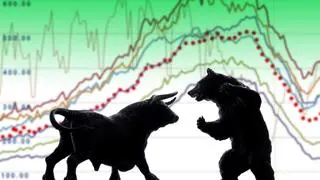Indian indices began last week on a weak note with a gap down opening, as Greece set to default on its debt repayment. This sparked off concerns on huge sell-offs in emerging markets. However, the indices recovered from Monday’s fall and started to trend higher thereafter. But the selling pressure mounted in developed markets such as Japan and Europe. The US markets were also under pressure and closed the truncated week on a negative note.
Domestic markets rallied to two-and-a-half month high for the third consecutive week. Greece default appears to have been factored in along with the better-than-expected progress on the monsoon. The April-June quarter earnings results and movement of oil and currency are important triggers to watch out for in the coming weeks.
Global markets, including India, will take cues from the outcome of the Greece referendum on July 5.
How they oscillate The Nifty decisively surpassed its 50- and 200-day moving averages last week. The relative strengthen index in the daily chart has entered the bullish zone from the neutral region, backed by a positive divergence during early June. Moreover, the moving average convergence divergence indicator featuring in the daily chart displayed positive divergence and entered the positive territory last week.
The weekly relative strength index has been moving higher in the neutral region since early June. Both the daily and weekly price rate of change indicators hover in the positive terrain, implying buying interest. Having said that, the monthly chart depicts a different picture, signalling weakness in long-term oscillators. There is a sell signal in the monthly MACD chart and the monthly price rate of change indicator is moving towards the zero line in the positive zone.
Nifty (8,484.9) After snapping its medium-term downtrend at a significant base between 7,950 and 8,000 in early June, the Nifty has been on a short-term uptrend. The index recorded an intra-week low on Monday, but went to breach its moving averages through the week.
The week ahead: The Nifty index extended its rally amidst volatility, and surged 103 points or 1.2 per cent. The index managed to surpass its critical resistance indicated at around 8,400 in the week ago. The short-term trend is up and the outlook is bullish. However, the index faces a tough task ahead in the form of a significant resistance at 8,500 and 8,535 — the 50 per cent fibonacci retracement of the decline from 9,119 levels.
If Nifty manages to decisively breach the significant resistance band between 8,500 and 8,535, it can rally to 8,666 levels in the short term. But, a reversal from the resistance zone can drag the index down to 8,340 and then to 8200 levels. Next key support is at 8,100 levels. Therefore, traders with a short-term view should tread with caution. Strong rally will be cue to initiate long positions.
Medium-term trend: We reiterate that the current rally needs to extend beyond 8,670 levels to signal that the medium-term trend has reversed higher.
But, a reversal from the resistance zone of around 8,535 will imply that the next leg of downtrend from 9,119 peak has resumed.
Sensex (28,092.7) After taking support in the range between 26,300 and 26,500 in early June, the Sensex started to trend higher. Last week, the index surpassed its immediate hurdle at 27,720 by gaining 280 points.
The week ahead: Since early June low, the index has been on a short-term uptrend. Though it managed to surpass a resistance last week, it faces a next one now at 28,200 levels. A strong rally above this level will pave way for an up move to 28,595 levels. However, the medium-term trend deciding level for the index is at 28,595. A positive close above this level will alter the trend to bullish. Key immediate supports for the index are at 27,800, 27,326 and 26,928 levels. Traders with a short-term perspective can initiate long positions if the index extends its rally beyond the immediate resistance level.
Global cues Since February 2015, the Dow has been on a sideways consolidation phase in the broad range between 17,600 and 18,300. Last week, the index tested the lower boundary as well as its 200-day moving average and bounced back slightly. But a decisive fall below 17,600 will have bearish implications and pull the index down to 17,300 and then to 17,100 levels in the short term. Conversely, the key resistances are placed at 18,000 and 18,300 which could limit its upside. Only a decisive rally above 18,300 will imply bullishness and take the index higher to 18,500 levels.
Most global indices, especially the euro zone, closed the week on a negative note. Shanghai Composite is the worst hit index plunging 12 per cent in the week ago.
After testing the key resistance level of $60 per barrel for almost two months, the Light Crude Oil tumbled 6.8 per cent in the previous week. Further fall below the immediate support level of $55 can drag crude oil prices down to $51.5 and then to $50 in the short term. On the other hand, an emphatic rally above $60 is needed to reinforce the uptrend.








Comments
Comments have to be in English, and in full sentences. They cannot be abusive or personal. Please abide by our community guidelines for posting your comments.
We have migrated to a new commenting platform. If you are already a registered user of TheHindu Businessline and logged in, you may continue to engage with our articles. If you do not have an account please register and login to post comments. Users can access their older comments by logging into their accounts on Vuukle.